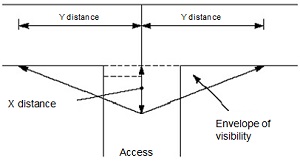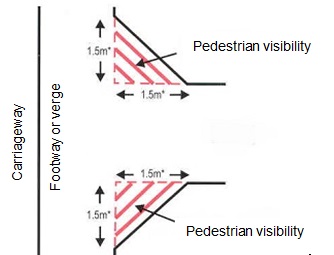Vehicle access crossing (dropped kerb)
A vehicle access crossing (or a dropped kerb) allows vehicles to safely cross the pavement and enter a driveway from the road.
To apply for a dropped kerb, please read the information below:
If you have any queries, please email trafficandnetwork@staffordshire.gov.uk
Please ensure that all requirements have been read and fully understood. If you submit an application knowing that certain requirements cannot be met your application will be refused and the administration charge is not refundable.
You are required to have read and understood the information within this page and understand the requirements for a dropped kerb.
For information relating to commercial accesses, please email trafficandnetwork@staffordshire.gov.uk.
Type of road
If you live on a classified road (A road, B road or C road) you will then require planning permission from your local borough/district council. During this time we will be unable to process the application until permission has been granted.
To check whether you live on a classified road, please use the website, Findmystreet or for further information and definitions, please visit Road and Maintenance status
Accredited contractor
Staffordshire County Council do not hold or maintain a list of registered contractors.
Please ensure that any contractor you engage holds the relevant accreditation and insurances which are detailed on the permit to dig application form, the contractor must obtain the permit to dig before works on the highway can commence.
Property owner
An application for a dropped kerb will only normally be considered when applied by the landowner, therefore you are required to state that you are the landowner on the applications. If you are a tenant you will require the permission from the relevant landlord.
Room required within your property
You must have sufficient room on your property for a vehicle to be parked without overhanging the highway. Desirable distance from the highway is 6 metres and the absolute minimum is 4.8 metres.
The above distances must be achieved in a transverse direction, i.e. perpendicular to the line of the road. Lateral parking (e.g. in line with the road) is not acceptable.
Width
A crossing will not be approved, or existing access widened, so that it will cover the width of the property. Standard width of a dropped kerb is 2.75 metres. You can request for your access to be widened but must state on application the reason.
Visibility
When applying for a vehicle access crossing you must take into consideration adequate visibility. Depending on the speed limit of the road, you will need to make sure that when leaving the access the driver must be able to see approaching vehicles travelling along the roadway from both directions at a minimum distance of 2 metres back from the edge of the carriageway. This is marked as X and Y distance on the diagram.

A driver's view of the roadway must be unobstructed and not restricted by objects such as hedges or walls; this is shown as the envelope of visibility in the diagram. The distance that the driver is required to see along the roadway will depend on the speed limit of the road.
Speed limit of a road and length of visibility that is required
| Speed limit of road (mph) | Length of visibility (metres) |
|---|
| 20 |
33 |
| 30 |
70 |
| 40 |
120 |
| 50 |
160 |
| 60 |
215 |
Pedestrian visibility
Pedestrian visibility is also another factor that needs to be considered when applying for a dropped kerb. Visibility for pedestrians are required to allow drivers to see pedestrians as they emerge from their access road, driveways or parking area and to allow pedestrians to see the vehicle.

Within the red zones indicated within the diagram obstructions such as walls or hedges must be kept below maximum height of 600 mm from ground level.
Multiple access crossings
Only one crossing into a property will be approved. Separate 'in and out' crossings are not normally permitted.
If you require a second access and there is specific justification, please include these details in the relevant section of the application form.
If you have vehicle access to the front and rear of your property, crossings at each frontage may also be allowed, provided it is not possible to drive from one to the other through the property.
Reasons for refusal
A dropped kerb will generally not be approved if it's:
- Within 15 metres of a road junction, or traffic signals crossing.
- Where an existing bus stop could be in the way of the proposed dropped kerb. The highway authority may consider relocating the stop as long as there is a suitable alternative available. The alternative location must be within 50 metres, in either direction of the existing stop.
- From a layby or other designated parking areas.
- £137 which is non-refundable and payable once the application has been received for the inspector to give an assessment to the site.
- £268 charge for a permit to dig on an unclassified street, which your contractor will apply for. Or £386 charge for a permit to dig in a classified street.
- Then you will be charged by the contractor for the works they carry out.
When submitting your application form please ensure that you have the following information or your application will be declined:
- A map showing exactly which road and the location of your property is required
- Copy of planning approval if the property is on an A, B or C road.
Apply online
Please note: If you submit an application knowing that certain conditions cannot be met your application with be refused and the administration charge is not refundable.
- Once we have received your application we check all details to make sure everything is there to process the application.
- If there is information missing we will not be able to process your application. At the time of taking payment, we will notify you of what must be provided so we can proceed with your application.
- An inspection will be carried out to check the safety implications at the location.
- Once inspected, you will receive a response, usually within 2-3 weeks. The response will indicate whether permission has been granted for a dropped kerb or whether the application has been refused. If the application has been refused, there will be reasons included within the written response.
Once approval has been granted you are required to:
- Organise a contractor (requirements apply) to carry out the works ensuring that the contractor is accredited and insured and obtains a permit to dig before works commence.
- Ensure works are planned correctly.
- Notify us if any issues arise.
Approved applications are valid for 3 years.
A dropped kerb will only be installed where it is safe to do so and where it does not interfere with the safety of the highway.
Works on the highway can only be undertaken by an insured accredited contractor. The contractor is required to obtain a permit to dig and it is necessary that we can ensure that the contractor has registered the necessary insurance.
The contractor must:
- Be registered with our network and traffic management register.
- Hold public liability insurance for the sum of £5 million with no limit on the number of claims. Both applicant and Staffordshire County Council will supply appropriate insurance certificates.
- Employees must be trained and accredited to the requirements of the Codes of practice set out in the New Roads and Street Works Act 1991.
- Follow our vehicle access crossing specification.
- Contractors are required to provide 20 days notice of proposed works.
Permissions
All applications are recorded by the highway authority and approvals are valid for 3 years. Works can be carried out at any time during these 3 years which is why it is important for the contractor to apply for a permit to dig at the time of works so that we are aware of when the necessary works are to be carried out.
Removal of access
Failure to comply with these requirements could result with the highway authority removing the access and reinstating the highway back to its original condition.
In these cases, a notice will be sent to the landowner a minimum of seven days before any works can take place. If there is no response from the landowner the highway authority will instruct works to commence and all costs can be recharged to the property.
Section 243 of the highway code states:
Do not stop or park:
- Where the kerb has been lowered to help wheelchair users and powered mobility scooters.
- In front of an entrance to a property.
- Anywhere you would prevent access for emergency services.
You can also apply for a white line (access protection marking) to be placed outside your property.